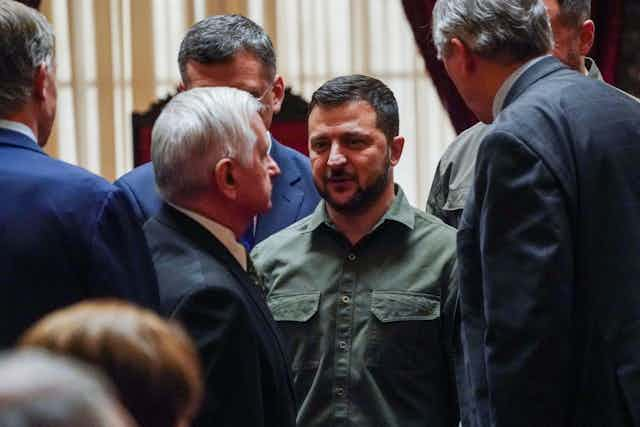The issue of military aid to Ukraine is still gridlocked in the US Congress, with Republicans refusing to support additional spending on arms for Ukraine, despite extensive lobbying by President Joe Biden.
The Senate’s Democrat majority leader, Chuck Schumer, has said: “The survival of Ukraine is on the line” – something reinforced by reports that the Ukrainian army is running low on ammunition.
The problem is, this issue has become embroiled in an argument about funding for increased controls on the border with Mexico, in response to the rising number of illegal immigrants crossing into the US. The Republican speaker of the House of Representatives, Mike Johnson, has made this an issue and he has been urged on by ex-president Donald Trump.
Despite further attempts to get the foreign aid and borders bill through Congress this week, Senate Republicans blocked the deal, including the new border measures. These involve an expedited asylum processing time, from years to six months, and raising the standard of proof for an asylum claim. Also included is a measure to restrict crossings if migrant levels reach 4,000 over a one-week period. Attempts to strip aid for Ukraine out of the combined bill, being led by Schumer, are due back for discussion in the Senate this week.
What the polls say
Polling in late 2023 by the Pew Research Center (below) suggested there is a short-term political advantage for the Republicans in combining the two issues. The Pew survey indicated that Republican voters are much more likely to think Ukraine has received too much aid from the US than Democrats or Americans in general.
Is the US providing too much aid to Ukraine?

In a Gallup survey from November 2023, some 44% of independents, who are the pivotal group in US electoral politics, thought this too. This helps to explain why the Republicans in Congress are pursuing a policy which arguably puts US long-term security at risk, if Ukraine loses the war. In relation to the bill in Congress, Senator Mark Warner from Virginia has said: “The Republicans should take Yes for an answer.”
It is worth stepping back and examining the attitudes of the American public to this issue before it became embroiled in the politics of a presidential election year. This can be done using the Cooperative Election Study (CES), a large academic survey conducted at the time of the US mid-term elections in November 2022.
As the name suggests, these elections take place in the middle of a presidential term of office, and they focus on voting for candidates in state legislatures and for both the Senate and House of Representatives. The CES study also asks respondents about voting for state governors and other state officials. Because of its widespread reach, the survey contained around 60,000 respondents, making it about 40 times larger than the average opinion poll.
The survey included the following question: “What do you think the United States should do in response to Russia’s invasion of Ukraine?” Respondents could select from a list of eight alternatives and choose more than one if they wished. The summary responses appear in the chart below.
US public responses to the Ukraine war

Perhaps not surprisingly, the most popular response was to send food, medical and other types of aid to the Ukrainians. However, it is noteworthy that providing arms was the second most popular alternative, and sending military support staff the fourth most popular. There was even modest support for the US Air Force to enforce a “no fly” zone, and a very small number who wanted to join in the war on the side of the Ukrainians by bombing the Russians and sending US troops into combat.
On the other side of the coin, only 22% said the US should not get involved at all, with a further 17% not sure what to do.
At a time when the American public were preoccupied with recovery from the COVID pandemic and facing economic hardship with inflation at 7%, large numbers were still in favour of helping Ukraine to defend itself with military aid.
Who favoured aid to Ukraine?
If we look at the category of CES respondents who favoured sending arms to Ukraine, a few things stand out in comparison with the population of the US in general. Some 59% of them were Democrat identifiers, compared with only 32% of Republicans.
Around 28% of college graduates, compared with only 21% of high school graduates, favoured arms to Ukraine. Similarly of those who were in favour, 57% had recently followed politics on social media, compared with 49% in the general population. Finally, 42% were from a household where someone had served in the military in the past, compared with 35% generally.
All this suggests that Americans who are Democrats, educated, regularly follow politics, and are from a family with personal experience of military service are most likely to favour supporting Ukraine with arms.
Despite support for aid to Ukraine coming from some people across both parties, it seems this issue is firmly tied up in the pre-election politics of the Trump campaign, and enmeshed in a struggle about new measures for the US-Mexico border. It’s not yet clear whether there is a way past these, although some senators on both sides still seem keen to find one.

